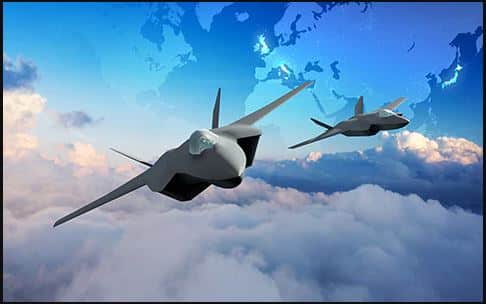Aerospace
UK industry to play key role in new Global Combat Air Programme

The UK’s sovereign industry partners, under Team Tempest, will support the significant endeavour announced today by the Governments of the UK, Japan and Italy, which will see the three nations build a truly international programme, with a shared ambition to develop a next generation fighter aircraft under a new Global Combat Air Programme (GCAP).
The joint announcement, highlights the close government, military and industrial links between the nations and reinforces the UK’s international commitment to future combat air. The programme will build on the substantial progress already made in the UK by BAE Systems, Leonardo UK, MBDA UK, Rolls-Royce and the UK Ministry of Defence who have been working in partnership since 2018 as Team Tempest to research, evaluate and develop a host of next generation future combat air systems capabilities.
The UK’s combat air industry not only supports national defence and security, but the £6bn-a-year sector also delivers substantial economic and social value. The GCAP could secure or create thousands of UK jobs while keeping irreplaceable combat air engineering skills onshore for another generation. A report published last year by analysts at PricewaterhouseCoopers (PwC) concluded that should the UK take a core role in a next generation fighter jet programme, it could expect to support an average of 21,000 jobs a year and contribution an estimated £26.2bn to the economy by 2050.
In the UK, around 2,500 people are already working on the programme as part of Team Tempest and wider industry. Beyond the Team Tempest partners, more than 580 organisations are already on contract across the UK, including 91 SMEs and 26 academic institutions. The Team Tempest partners have recruited more than 1,000 apprentices and graduates since the launch of the project in 2018, with young people nationwide inspired by the opportunity to be part of a once-in-a-generation combat air programme.
Qantas and Airbus Partnership for the biofuel industry.(Opens in a new browser tab)
The UK industry partners have already generated strong working relationships with their counterparts in Italy and Japan, which will progress into the new joint development. These include IHI Corporation, Mitsubishi Electric and Mitsubishi Heavy Industries in Japan, and Avio Aero, Elettronica and Leonardo in Italy.
It is expected that GCAP will generate long-term technological, industrial and social benefits for the three partner countries and inspire the next generation of engineering talent.

Aerospace
Boeing Transfers Rocket Stage to NASA, Paving Way for Human Moon Mission

Boeing has achieved a significant milestone by providing NASA with the second core stage of the Space Launch System (SLS) rocket.
This crucial component, crafted at NASA’s Michoud Assembly Facility (MAF), is set to propel the Artemis II crew into lunar orbit, marking humanity’s return to deep space after a 50-year hiatus.
The monumental Boeing-built rocket stage, the largest element of the Artemis II mission, will embark on a journey aboard the Pegasus barge, traveling 900 miles to NASA’s Kennedy Space Center.
Comparison of two legendary aircraft B777x vs B747 aircraft:Click here
Upon arrival, it will be meticulously integrated with other essential Artemis II components, including the upper stage, solid rocket boosters, and NASA’s Orion spacecraft within the iconic Vehicle Assembly Building. This intricate integration process is a vital step toward the eagerly anticipated Artemis II launch, slated for 2025.
“Boeing-built products helped land humankind on the moon in 1969, and we’re proud to continue that legacy through the Artemis generation,” remarked Dave Dutcher, vice president and program manager for Boeing’s SLS program. “Together, with NASA and our industry partners and suppliers, we are building the world’s most capable rocket and paving the way to deep space through America’s rocket factory in New Orleans.”
NASA, Lockheed Martin Reveal X-59 Quiet Supersonic Aircraft:Click here
The delivery of Core Stage 2 marks a significant achievement in the evolution of the SLS rocket. Towering over 200 feet and powered by four RS-25 engines, this core stage, coupled with two solid-fueled booster rockets, will generate a staggering 8.8 million pounds of thrust. This immense power is crucial to launching Artemis II and future missions into the vast expanse of space.
The SLS rocket stands unparalleled in its capability to transport both crew and substantial cargo to the moon and beyond in a single launch. Its extraordinary capacity will facilitate the delivery of human-rated spacecraft, habitats, and scientific missions to destinations including the moon and Mars, ushering in a new era of space exploration.
-

 Travel1 week ago
Travel1 week agoAir India to Expand US Operations with Three New Routes After a Decade
-

 Travel2 weeks ago
Travel2 weeks agoWhy We Should Avoid These Stamps in a Passport
-

 Airlines1 month ago
Airlines1 month agoInvestigations Reveal Fake Chinese Titanium in Boeing and Airbus Jets
-

 Tech4 weeks ago
Tech4 weeks agoChina’s CATL Plans 1,800-Mile Electric Plane Launch by 2027
-

 Airport3 days ago
Airport3 days agoTop 10 Largest Airports in the World by Size
-

 Aerospace4 weeks ago
Aerospace4 weeks agoChina’s Fighter Jets Turn Wings into Autonomous Drones
-

 Airlines4 days ago
Airlines4 days agoAir India Rolls Out A350s for Delhi-New York JFK and Newark Routes
-

 Defence3 weeks ago
Defence3 weeks agoBoeing Enhances Chinook with New Engines and Block II Upgrades at $96 Million







